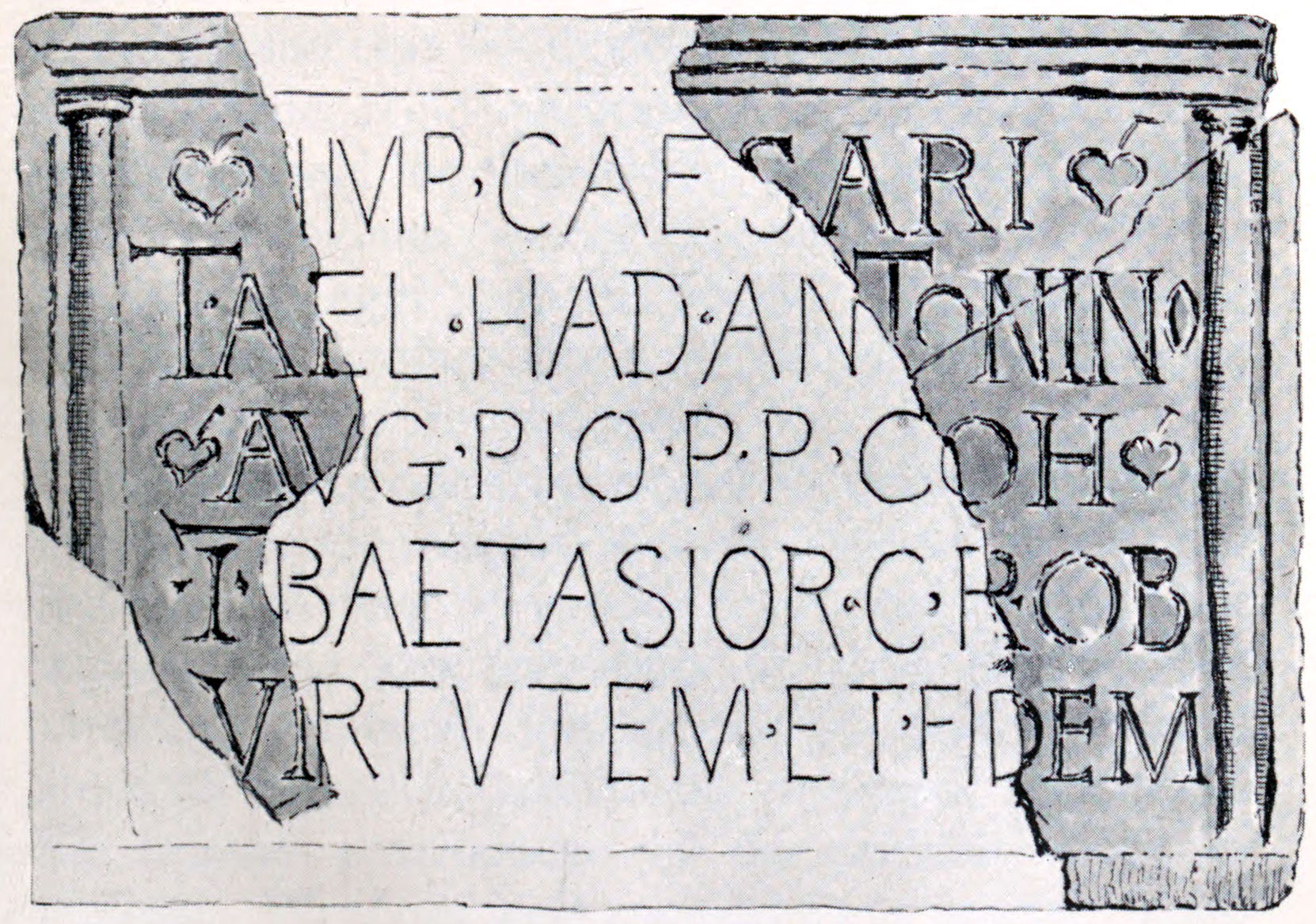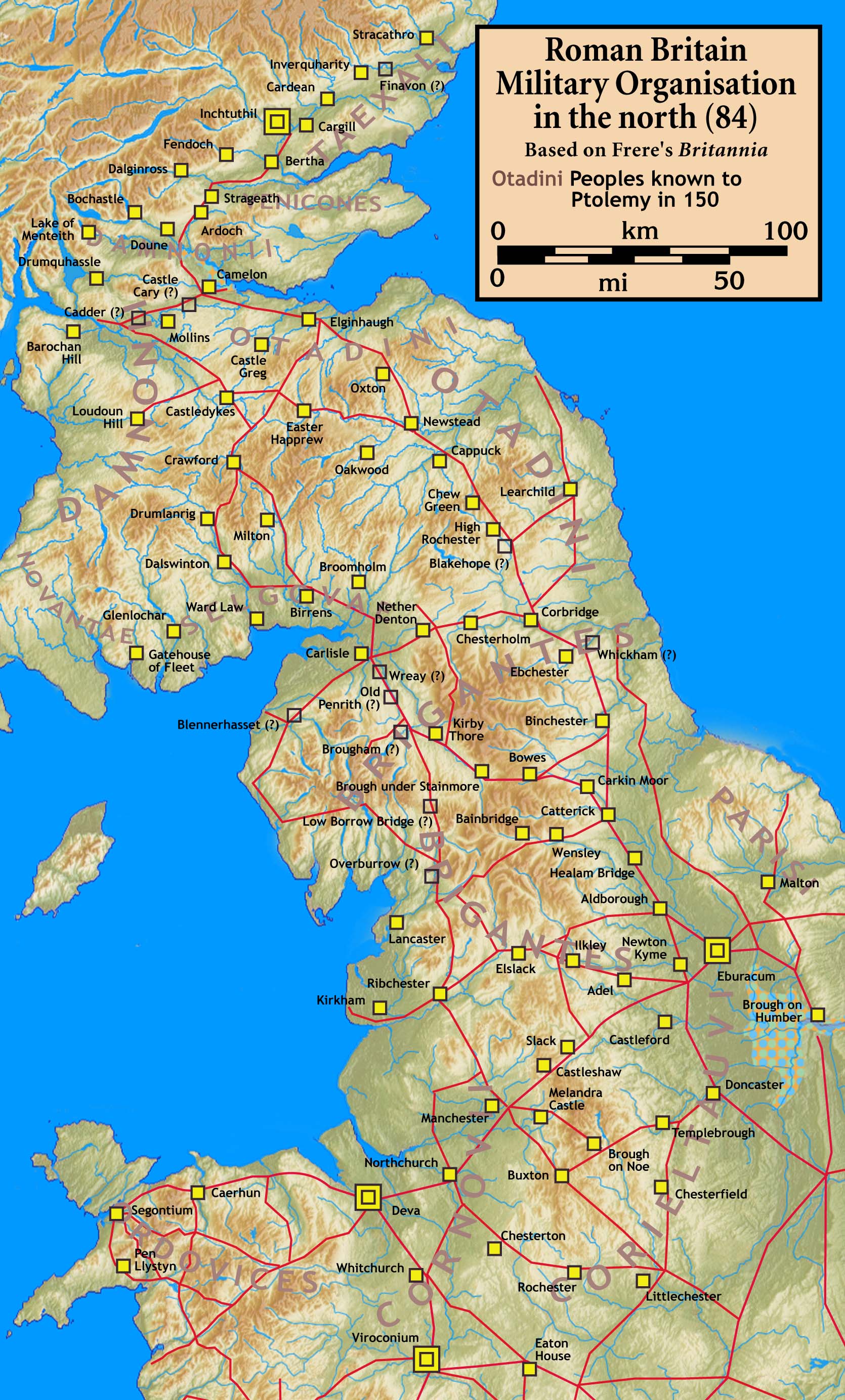|
Bar Hill Fort
Bar Hill Fort was a Roman fort on the Antonine Wall in Scotland. It was built around the year 142 CE. Older maps and documents sometimes spell the name as Barr Hill. A computer generated fly around for the site has been produced. Lidar scans have been done along the length of the wall including Bar Hill. Sir George Macdonald wrote about the excavation of the site. Many other artefacts have also been found at Shirva, about a mile away on the other side of Twechar. Many Roman forts along the wall held garrisons of around 500 men. Larger forts like Castlecary and Birrens had a nominal cohort of 1000 men but probably sheltered women and children as well although the troops were not allowed to marry. There is likely too to have been large communities of civilians around the site. An altar (RIB 2167) to Silvanus was found in 1895 on Bar Hill. It's thought to have originated from a small shrine outside the fort. The altar is now kept in the Hunterian Museum, Glasgow along ... [...More Info...] [...Related Items...] OR: [Wikipedia] [Google] [Baidu] [Amazon] |
Twechar
Twechar is a small former Pit village, mining village historically in Dunbartonshire and administered by the council area of East Dunbartonshire, Scotland close to the boundary with North Lanarkshire. It lies between the larger towns of Cumbernauld, Kilsyth and Kirkintilloch. The Forth and Clyde Canal runs close to the village to the north, and closely follows the line of the Antonine Wall. There are visible remains of the wall on Bar Hill Fort, Bar Hill and the Roman Fort is a local tourist attraction. History The etymology of the name is probably ‘causeway or pavement’. Several old documents show Twechar with various spellings including maps by Charles Ross, and William Roy. There is a long history of mining activity in the Twechar locality but it was not until the coming of William Baird & Co. to the area, about 1860, that a close-knit mining community was created. Before that time Shirva was described as having the best farm land in the parish. Several tombstones from a ... [...More Info...] [...Related Items...] OR: [Wikipedia] [Google] [Baidu] [Amazon] |
Blatobulgium
Blatobulgium was a Roman fort, located at the modern-day site known as Birrens, in Dumfriesshire, Scotland. It protected the main western road to Scotland. It was one of the "outpost forts" outside the Roman Empire when the frontier was on Hadrian's Wall and was located about 11 miles from the Castra Exploratorum fort (Netherby, Cumbria). Name Blatobulgium is recorded in the Antonine Itinerary. The name derives from the Brittonic roots ''*blāto-'' 'bloom, blossom' or ''*blāto-'' (from earlier ''*mlāto-''), 'flour' and ''*bolgo-'', 'bag, bulge'. The name may mean 'flowery hillock' or 'flowery hollow'. However, as there are granaries at the fort, Blatobulgium may be a nickname meaning ' Flour Sacks'. History There are several camps near Birrens at least one of which was first occupied in the Flavian period from 79 AD onwards probably during the Agricolan campaigns, when its internal buildings were presumably of timber. Under Hadrian when the frontier was established on ... [...More Info...] [...Related Items...] OR: [Wikipedia] [Google] [Baidu] [Amazon] |
Forts Of The Antonine Wall
A fortification (also called a fort, fortress, fastness, or stronghold) is a military construction designed for the defense of territories in warfare, and is used to establish rule in a region during peacetime. The term is derived from Latin ("strong") and ("to make"). From very early history to modern times, defensive walls have often been necessary for cities to survive in an ever-changing world of invasion and conquest. Some settlements in the Indus Valley Civilization were the first small cities to be fortified. In ancient Greece, large cyclopean stone walls fitted without mortar had been built in Mycenaean Greece, such as the ancient site of Mycenae. A Greek '' phrourion'' was a fortified collection of buildings used as a military garrison, and is the equivalent of the Roman castellum or fortress. These constructions mainly served the purpose of a watch tower, to guard certain roads, passes, and borders. Though smaller than a real fortress, they acted as a border gu ... [...More Info...] [...Related Items...] OR: [Wikipedia] [Google] [Baidu] [Amazon] |
Old Kilpatrick
Old Kilpatrick (, meaning "Patrick's church"), is a village in West Dunbartonshire, Scotland. The name ''Old Kilpatrick'' is said to be derived from St. Patrick ostensibly being born here. It has an estimated population of 4,820. It belonged to the parish of Old Kilpatrick which itself was only a few thousand people strong. The Forth and Clyde Canal separates Old Kilpatrick from the north bank of the River Clyde which is just a few metres beyond it to the south. The village is about west of Clydebank, on the road west to Dumbarton where some say the river becomes the Firth of Clyde. The Great Western Road runs through the village whose immediate western neighbour, on the road and the canal, is Bowling, where the Forth and Clyde Canal meets the river. The modern A82 road runs to the north, between the village and the foot of the Kilpatrick Hills. In the 19th century it was described as being essentially a single street. It's possible the birthplace of Saint Patrick was near Old ... [...More Info...] [...Related Items...] OR: [Wikipedia] [Google] [Baidu] [Amazon] |
Camulus
Camulus or Camulos is a Celtic deity who was identified with Mars via ''interpretatio romana''. Camulus was an important god of Roman Britain and Gaul, especially among the Belgae and the Remi, Gaulish tribes that originate from the areas of modern day Belgium, Luxembourg, Northern France and parts of Germany and the Netherlands. Name The etymology of the name is uncertain. It has been compared with the Old Irish , meaning 'champion'. Attestations Evidence of Camulus' popularity can be seen in several place-names, notably Camulodunum. Camulus is named in combination with Mars in inscriptions coming from Reims, Arlon, Kruishoutem, Rindern, Mainz, Bar Hill Fort near the Antonine Wall, Sarmizegetusa, and Southwark, London. The town Camulodunum (now Colchester) in Essex may have been named after him (and is the conjectured basis for the legendary city of Camelot). Camulodunum is a Latinised form of the Brittonic ''Camulodūnon'' from ''Camulos'' plus '' dūnon'' "(hill) ... [...More Info...] [...Related Items...] OR: [Wikipedia] [Google] [Baidu] [Amazon] |
Laconicum
The ''laconicum'' (i.e. Spartan, ''sc.'' ''balneum'', "bath") was the dry sweating room of the Roman ''thermae'', sometimes contiguous to the ''caldarium'' or hot room. The name was given to it (Laconia: Sparta) since it was the only form of warm bath that the Spartans admitted. The ''laconicum'' was usually a circular room with niches in the axes of the diagonals and was covered by a conical roof with a circular opening at the top, according to Vitruvius (v. 10), from which a brazen shield is suspended by chains, capable of being so lowered and raised as to regulate the temperature. It is similar to a '' sudatorium'', or steam bath, where water is added to produce steam. Sometimes, as in the old baths at Pompeii, the ''laconicum'' was provided in an apse at one end of the ''caldarium'', but as a rule it was a separate room raised to a higher temperature and had no bath in it. In addition to the hypocaust under the floor, the wall was lined with ceramic flue pipes. The largest '' ... [...More Info...] [...Related Items...] OR: [Wikipedia] [Google] [Baidu] [Amazon] |
Twechar From The Air (geograph 4517301)
Twechar is a small former mining village historically in Dunbartonshire and administered by the council area of East Dunbartonshire, Scotland close to the boundary with North Lanarkshire. It lies between the larger towns of Cumbernauld, Kilsyth and Kirkintilloch. The Forth and Clyde Canal runs close to the village to the north, and closely follows the line of the Antonine Wall. There are visible remains of the wall on Bar Hill and the Roman Fort is a local tourist attraction. History The etymology of the name is probably ‘causeway or pavement’. Several old documents show Twechar with various spellings including maps by Charles Ross, and William Roy. There is a long history of mining activity in the Twechar locality but it was not until the coming of William Baird & Co. to the area, about 1860, that a close-knit mining community was created. Before that time Shirva was described as having the best farm land in the parish. Several tombstones from a possible Roman Cemetery wer ... [...More Info...] [...Related Items...] OR: [Wikipedia] [Google] [Baidu] [Amazon] |
Forth And Clyde Canal
The Forth and Clyde Canal is a canal opened in 1790, crossing central Scotland; it provided a route for the seagoing vessels of the day between the Firth of Forth and the Firth of Clyde at the narrowest part of the Scottish Lowlands. This allowed navigation from Edinburgh on the east coast to the port of Glasgow on the west coast. The canal is long and it runs from the River Carron at Grangemouth to the River Clyde at Bowling, and had an important basin at Port Dundas in Glasgow. Successful in its day, it suffered as the seagoing vessels were built larger and could no longer pass through. The railway age further impaired the success of the canal, and in the 1930s decline had ended in dormancy. The final decision to close the canal in the early 1960s was made due to maintenance costs of bridges crossing the canal exceeding the revenues it brought in. However, subsidies to the rail network were also a cause for its decline and the closure ended the movement of the east-coast F ... [...More Info...] [...Related Items...] OR: [Wikipedia] [Google] [Baidu] [Amazon] |
Central Belt
The Central Belt of Scotland is the Demographics of Scotland, area of highest population density within Scotland. Depending on the definition used, it has a population of between 2.4 and 4.2 million (the country's total was around 5.4 million in 2019), including multiple List of towns and cities in Scotland by population, major Scottish settlements such as Paisley, Renfrewshire, Paisley, Glasgow, East Kilbride, Livingston, West Lothian, Livingston, and Edinburgh. Despite the name, it is not geographically central but is nevertheless at the "waist" of Scotland on a conventional map and the term "central" is used in many Subdivisions of Scotland, local government, police, and NGO designations. It was formerly known as the Midlands or Scottish Midlands, but this term has fallen out of fashion. The Central Belt lies between the Scottish Highlands, Highlands to the north and the Southern Uplands to the south. In the early 21st century, predictions were made that due to economic mi ... [...More Info...] [...Related Items...] OR: [Wikipedia] [Google] [Baidu] [Amazon] |
Silenus
In Greek mythology, Silenus (; , ) was a companion and tutor to the wine god Dionysus. He is typically older than the satyrs of the Dionysian retinue ('' thiasos''), and sometimes considerably older, in which case he may be referred to as a Papposilenus. ''Silen'' and its plural ''sileni'' refer to the mythological figure as a type that is sometimes thought to be differentiated from a satyr by having the attributes of a horse rather than a goat, though usage of the two words is not consistent enough to permit a sharp distinction. Silenus presides over other daimons and is related to musical creativity, prophetic ecstasy, drunken joy, drunken dances and gestures. In the decorative arts, a "silene" is a Silenus-like figure, often a "mask" (face) alone. Evolution The original Silenus resembled a folkloric man of the forest, with the ears of a horse and sometimes also the tail and legs of a horse. The later sileni were drunken followers of Dionysus, usually bald and fat with th ... [...More Info...] [...Related Items...] OR: [Wikipedia] [Google] [Baidu] [Amazon] |







